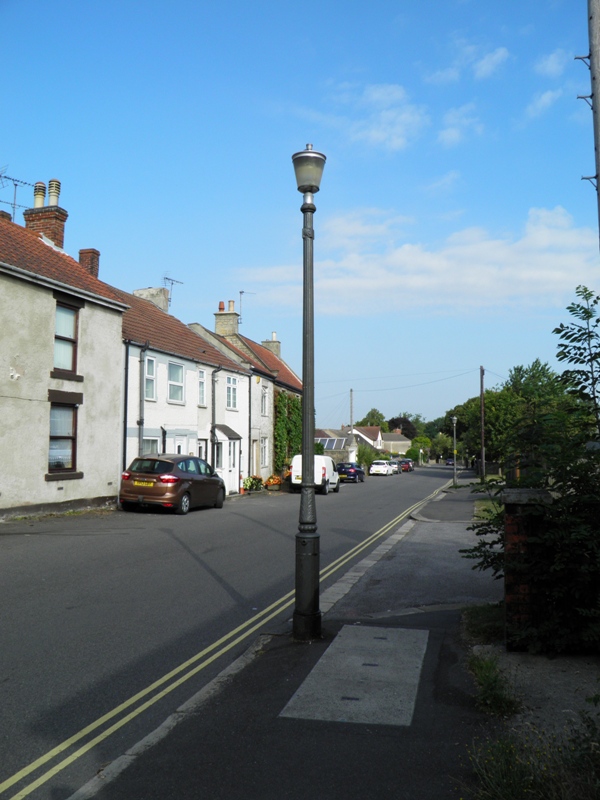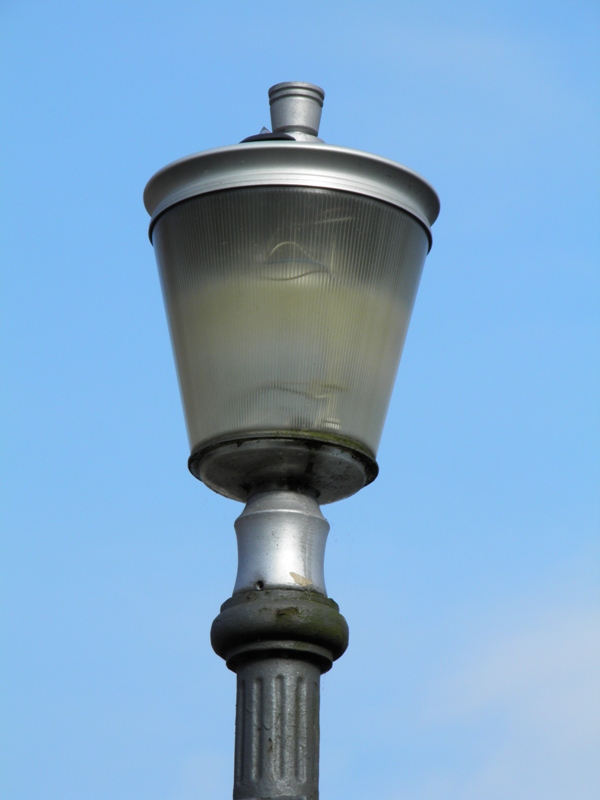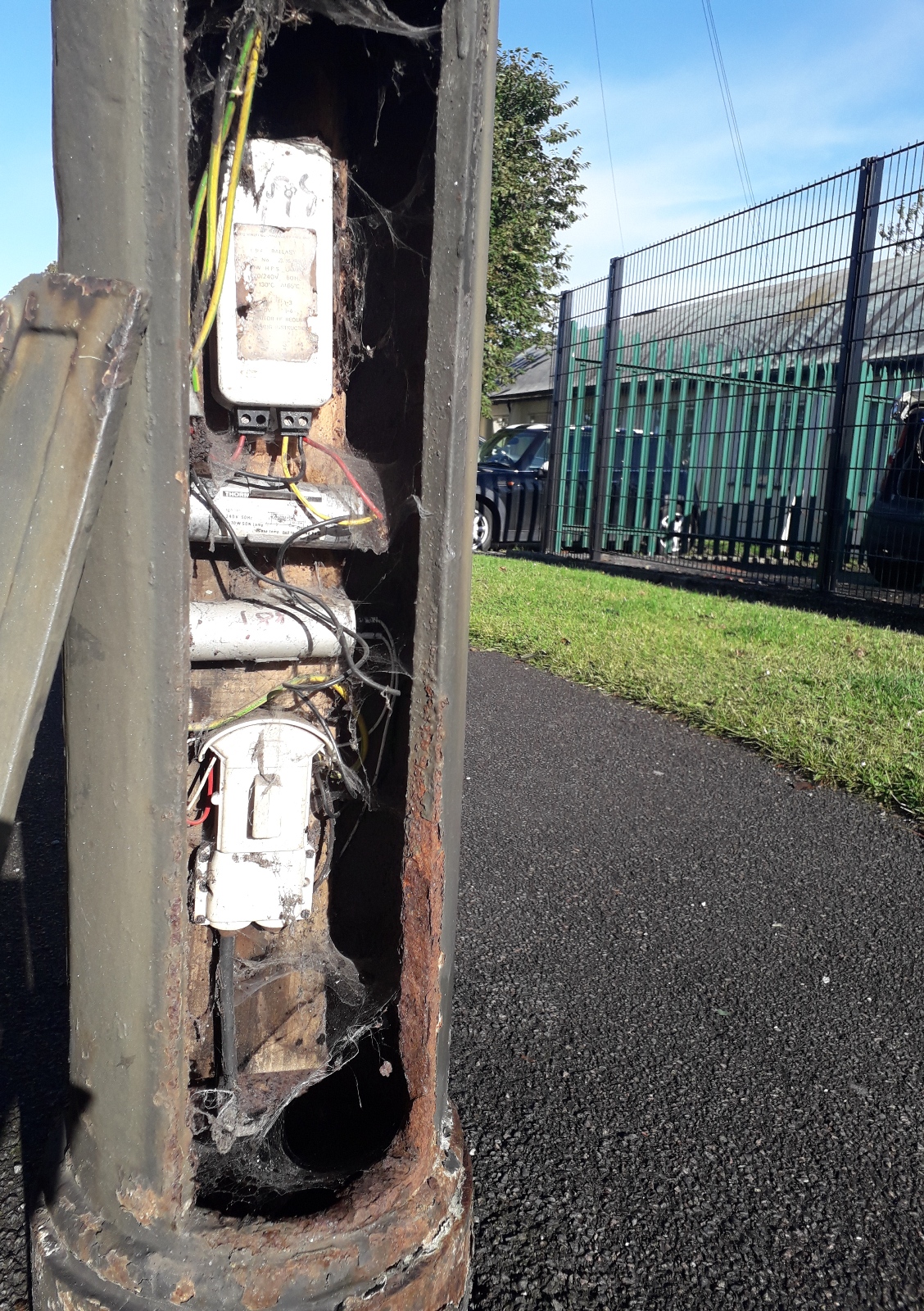
GEC Z5640
Lantern acquired in September 2021.
This lantern was removed from High Street, Bolsover, owing to the lamp having failed, and there being no replacements left in stock that would allow it to continue in service. A Phosco P852 LED lantern was used as the Z5640's replacement, although a 'heritage' LED post-top is likely to be fitted in the future. In Derbyshire, the Z5640 was unique to this part of Bolsover, with several examples being seen around the historical Castle.
The lantern is pictured below, attached to its cast iron column. The columns are believed to be Revo products (with the decoration above the base resembling the 'Hull' design), although unusually, no manufacturer is stated.

A Royce Thompson P10 photocell is seen on the lantern's canopy, or what looked to be one, anyway.

An adjacent column to the one that supported this lantern contains a GEC 70 Watt SON ballast (of identical design to Thorn's G53320.T ballast), along with a Thorn ignitor, and capacitor of uncertain manufacturer; all components appear to have been fitted in 1988.

The lantern is identifiable by its cast aluminium finial and base section, and distinctive canopy shape, and first appeared in early 1950s' catalogues (a theory, unfounded, is that its crown-like appearance could have been inspired by Queen Elizabeth II's Coronation in 1953). It is 13 inches (330 mm) in diameter, and 24 inches (610 mm) in height. The bowl used (GEC part code Z6701) is common to the later Z567# and Z569# series of lanterns, as well as some D.W. Windsor post-tops.
The canopy would have painted a light hammered grey finish when new. Over time, this has worn away, exposing the bare aluminium beneath.
The lower section of the bowl (Z6700) is a separate moulding to the rest, and is fixed to the base spigot. The idea behind it was to reduce shadows around the column base, but this idea was not continued with later GEC post-tops.
The finial serves as a means of securing the canopy under normal operation. This unscrews from an internal thread, allowing the canopy (and bowl) to be removed.
The thread is visible below - there is considerable tolerance allowed if the internal construction is not quite central.
Opening the canopy reveals that the photocell is actually a newer P10E (the 'E' representing 'electronic', as in the type of relay employed; earlier P10s employed a thermal relay instead). The photocell provision may have been fitted before the lanterns were installed on site.
Peering down inside the lantern reveals its internal construction.
Sadly, metal fatigue has broken one of the limbs that holds the refractor ring bracket steady on the two support rods, causing the refractor to sag onto the lamp slightly. This component is identical to the one seen in the Z5671, although in that case, the refractor attaches to the inside of the canopy.
Removing the bowl allows a better view of the lamp to be gained. The lantern ended its days on the street running an internal-ignitor high pressure sodium (SON) lamp; the external ignitor in the column base having failed at some point previously.
'Street Side' is marked on the underside of the refractor support casting, in order that the lantern is aligned correctly in respect of the refractor. With this example, however, the glassware has been rotated out of position slightly, meaning that the main beam would be offset too - not that this would be especially noticeable.
Twists of wire (which may be factory-fitted) provide some support for the various wires that pass up this support rod. A black plastic connector block serves as the main wiring termination point in this lantern. The cable clamp is also plastic on this example. Earlier versions used porcelain for both instead, making me believe that this could be a late Z5640 example.
The base section is secured with a locknut.
The refractor contains the GEC logo, the part code (Z6508 - for asymmetric distribution), Made in England (naturally!) and, assuming that it follows the same orientation, the number '86', which could, of course, represent 1986 as a manufacturing year, although what confuses things is that I don't think that the Z5640 was still in production by then. The 1988 dates on the gear would support this possibility, however.
The lantern was sent to TAS Engineering of Burton-upon-Trent, for repair, including filling in the hole in the canopy that was made to accommodate the photocell, and straightening out a slight distortion in the canopy. After that, the components were taken to R.L. Dumelow & Son, also of Burton, for bead blasting and repainting. A hammered grey finish was employed on the canopy, in order to match the original patina.
The inside was repainted in the same way.
The base casting's jammed grub screws were removed, followed by the casting being painted light silver.
The refractor was cleaned in the dishwasher, in order to remove all dirt deposits, and to restore the shine to the glassware.
The existing lampholder wiring was brittle and unusable, having been subjected to the continued heating from the lamp over the course of the lantern's operation on the street. The incoming live wire had noticeably thick insulation; presumably, because of the high voltage pulses that would pass through the wire during ignition. A bad connection appeared to have developed at the point where this wire terminated into the lampholder, leaving the terminal corroded and the lampholder requiring replacement. Notice that the insulation at the end of this wire is burnt.
Inside, the centre pin that connects to this terminal was also corroded heavily. The bad connection could have been a factor in the external ignitor having failed.
TAS completed the repairs to the damaged casting that supports the refractor dome.
The break was repaired using a strong adhesive, with thin strips of metal placed on both sides, to strengthen the repair.
The refractor was reunited with its repaired support.
TAS fabricated a post-top wall bracket for the Z5640. It is seen here with the partly-reassembled lantern. A new lampholder, lamp and internal wiring were added.
The additions of the bowl, canopy and top finial signified the completion of the Z5640's restoration...only one thing left to do!
With a Thorn G53320.T ballast and G53353.4 ignitor (and 12 µF capacitor) installed remotely, the lantern was back in operation for the first time in over a year (30th September 2022).
The transparent underside produced an interesting view when seen from below.
Lamp warm-up video:
Testing with my energy monitoring device revealed the following results:
| Test Voltage (V) | Current being drawn at full power (A) | Measured wattage (W) | Apparent Power (VA) | Frequency (Hz) | Power Factor | True Power (W) | Difference to rated wattage | Percentage Difference |
| 243 | 0.45 | 89 | 109 | 49.9 | 0.82 | 89.67 | 19.67 | 28.10% |
AEL Contempo 245 | ELECO HW-898
CLICK HERE TO MAKE A MONETARY DONATION
© 2002 - English Street Lights Online